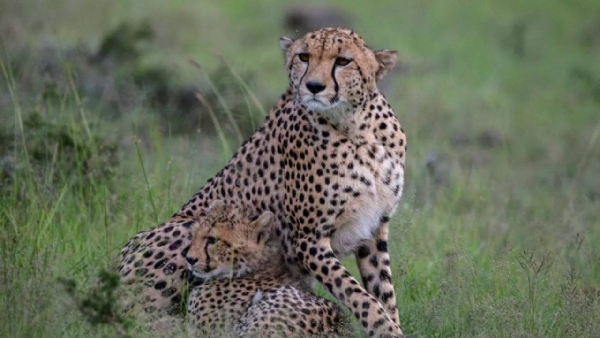BIG! India inks pact with Namibia for reintroduction of Cheetahs after 7 decades
The main goal of Cheetah reintroduction project in India is to establish viable cheetah metapopulation in India that allows the cheetah to perform its functional role as a top predator and provides space for the expansion of the cheetah within its historical range thereby contributing to its global conservation efforts.
Total Views | 210
New Delhi, July 20: In a significant development, India and Namibia on Wednesday signed a "historic" memorandum of understanding (MoU) for the restoration of cheetahs, declared extinct in the country in 1952.
"Happy to share that India has signed a historic MoU with Namibia to promote Wildlife Conservation and Sustainable Biodiversity Utilization. The MoU seeks to promote conservation and restoration of cheetah in their former range from which the species went extinct," Union Environment Minister Bhupender Yadav tweeted.

"Cheetah as a flagship specie will lead to greater focus on the status of dry-open forest/savanna ecosystems and the need to restore and manage them. Cheetah reintroduction would also greatly enhance local community livelihoods through eco-tourism prospects in the long term. Completing 75 glorious years of Independence with restoring the fastest terrestrial flagship species, the cheetah, in India, will rekindle the ecological dynamics of the landscape," he added.
India is expected to get a dozen of Cheetah from Namibia under the pact. It is pertinent to mention this is probably the first pact anywhere in the world for the transcontinental transfer of such large numbers of carnivorous animals. The Cheetahs from the African country will be relocated to MP's Kuno Wildlife Sanctuary.
Also Read: Cheetahs to be brought from Africa to Kuno National Park in MP as promised
Cheetahs, the fastest land animal got extinct in India in the 1950s, majorly because of excessive hunting. The last cheetahs in the wild were recorded in 1948 when three cheetahs were shot in the forests of Koriya District, Chhattisgarh. In past India was discussing such developments with Iran but did not go well.
The Cheetah reintroduction project
Cheetah has a very special significance for the national conservation ethic and ethos. Bringing the cheetah back to India would have equally important conservation ramifications. Cheetah restoration will be part of a prototype for restoration of original cheetah habitats and their biodiversity, helping to stem the degradation and rapid loss of biodiversity.
Among large carnivores, conflict with human interests are lowest for cheetahs, as they are not a threat to humans and usually do not attack large livestock. Bringing back a top predator restores historic evolutionary balance resulting in cascading effects on various levels of the ecosystem leading to better management and restoration of wildlife habitat (grasslands, scrublands and open forest ecosystems), conservation of cheetah’s prey and sympatric endangered species and a top-down effect of a large predator that enhances and maintains the diversity in lower trophic levels of the ecosystems.
Surveys for 10 sites were conducted between 2010 and 2012. From the potential sites evaluated for the feasibility of establishing cheetah populations in India based on IUCN guidelines for reintroductions that consider species viability according to demography, genetics and socio-economics of conflict and livelihoods, Kuno National Park in the state of Madhya Pradesh was considered ready for receiving cheetah with the least management interventions since a lot of investments had been done in this Protected Area for reintroducing Asiatic lions.
Cheetah presence locations from Southern Africa (South Africa, Namibia, Botswana and Zimbabwe) were used along with relevant eco-climatic covariates to model equivalent niche space in India using Maximum Entropy Models. The analysis shows that the climatic niche of the cheetah from southern Africa exists in India with Kuno National Park having a high probability of cheetah habitat suitability.
The action plan for cheetah translocations in Kuno National Park has been developed in compliance with IUCN guidelines and considering site assessment and prey density, current cheetah carrying capacity of Kuno National Park, among other criteria. While the current carrying capacity for Kuno National Park is a maximum of 21 cheetahs, once restored the larger landscape can hold about 36 cheetahs. The carrying capacity can be further enhanced by including the remaining part of the Kuno Wildlife Division (1,280 sq km) through prey restoration.
Financial and administrative support to the cheetah reintroduction programme in India would be provided by MoEF&CC through NTCA. Participation of Government and corporate agencies through Corporate Social Responsibility (CSR) would be encouraged for additional funding at the State and Central level. The Wildlife Institute of India (WII), national and international carnivore/cheetah experts/agencies would provide technical and knowledge support to the programme.
Also Read: After 69 years, Cheetah to be again introduced in India
The officials of the MoEF&CC, NTCA, WII, State Forest Departments would be sensitized to ensure the success of cheetah reintroduction in India, through capacity building programs in Cheetah conservation reserves of Africa. In addition, the Cheetah managers and biologists from Africa would be invited to impart training of Indian counterparts.
The Kuno National Park management will be responsible for monitoring which is essential for protection and management while a cheetah research team will monitor for research. Various outreach & awareness programmes will be conducted to encourage participation of local villagers. Sarpanches (village head men), local leaders, teachers, social workers, religious figures and NGOs would be provided with a better stake in the conservation. Awareness programmes are also planned for schools, colleges and villages sensitizing people about the conservation and various schemes available with the forest department.
Public awareness campaigns are underway for the local communities with a local mascot named “Chintu Cheetah”. The Chief Minister of Madhya Pradesh has asked all state officials and elected members of the state assembly from the constituencies around Kuno National Park to disseminate information regarding the cheetah-human interface.
As per the directions of the Supreme Court of India in 2020, the cheetah reintroduction in India is being overseen by the National Tiger Conservation Authority (NTCA), Ministry of Environment, Forest and Climate Change (MoEF&CC), guided and directed by the committee of experts designated by the Supreme Court of India.







